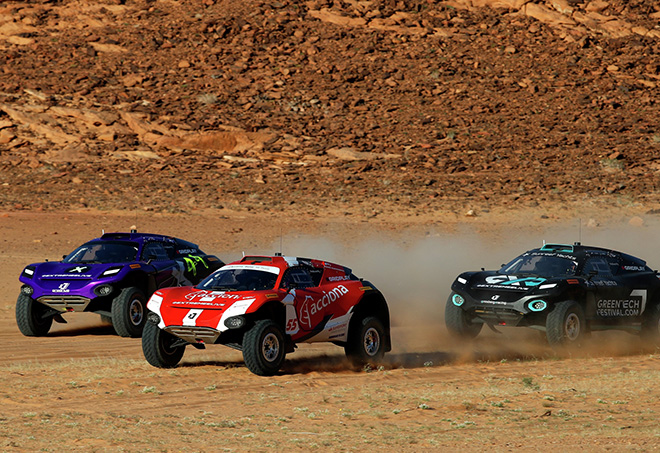If Formula E is a dignified ambassador for electric performance, Extreme E is an in-your-face wild beast (but with a green conscience). Custom electric off-road SUVs tear through some of the harshest and most vehicle-punishing terrain on the globe.
Extreme E’s first race, the Desert X Prix, took place on April 3 and 4, on an 18 km course centered around three canyons in the vast desert surrounding Al-‘Ula, Saudi Arabia. A shakedown run was followed by four qualifying time trial sessions, then four race events: Semi-final, Final, Crazy Race and Shootout.
Rosberg X Racing duo Johan Kristoffersson and Molly Taylor took the checkered flag after setting the pace from the outset of the Final race.
“It was definitely extreme,” said Molly Taylor. “It was the first time we had experienced terrain like that, and on every lap, the course was changing—there were so many different variables to deal with.”
The dust clouds kicked up on this course are so intense that they pose a real visibility problem for drivers who aren’t in the lead. “I really didn’t want to be in the dust after seeing some of the on-boards [camera views],” said Johan Kristoffersson. “Those first 30 seconds of the race are what you are really working for, when the adrenaline is pumping the fastest—we’re all adrenaline junkies here, and that’s the feeling you really want.”
The Odyssey 21 racer was built by Spark Racing Technology. The E-SUV is 2.3 meters wide and weighs 1,650 kg. Its dual motors pack a total 400 kw (550 hp) of power, and are capable of firing from 0-62 mph in 4.5 seconds, and handling gradients of up to 130 percent. The battery pack, made by Williams Advanced Engineering, is enclosed in a rugged lightweight enclosure of carbon fiber composite, and has a capacity of 54 kWh (40 kWh usable).
Sustainability is at the heart of Extreme E’s mission. The race sites were chosen not only for their challenging terrain, but in order to highlight the environmental threats to each of the four unique ecosystems: desert, glacier, ocean and rain forest. The carbon footprint is as small as practical: there are no spectators, and the cars and teams travel on a specially greened-up ship, the St. Helena. Extreme E invests in a local environmental project at each site.
Equality is also a priority—each of the 9 racing teams consists of one male and one female driver, who take turns at the wheel of a single car.
“We chose to organise our first-ever race in Al-‘Ula, with the aim to shed light on the threats presented by desertification,” said Alejandro Agag, founder and CEO of Extreme E. “The magnificent sand dunes and breathtaking views of Al-‘Ula represent the perfect backdrop to showcase the exploits of the innovative engineering masterpieces and the world-class driving capabilities taking part in the competition.”
The next issue of Charged will feature a detailed article on Extreme E, including an interview with one of the engineers who designed the championship’s custom fuel cell-based charging system.
Source: Extreme E

purchase lasuna without prescription – how to buy lasuna buy himcolin
I found this article to be very eye-opening. Thanks for sharing.
buy besivance generic – order sildamax order sildamax
neurontin 600mg sale – buy generic ibuprofen over the counter buy azulfidine 500mg without prescription
celecoxib online order – indomethacin price indomethacin 50mg uk
colospa price – order generic mebeverine cilostazol 100mg us
order diclofenac 50mg – aspirin online aspirin 75 mg uk
rumalaya price – buy shallaki elavil 50mg us
mestinon 60 mg oral – order imitrex 50mg order azathioprine 50mg pills
buy generic diclofenac online – buy generic nimodipine for sale buy nimodipine pills for sale
lioresal order online – buy cheap ozobax purchase piroxicam
buy cheap generic mobic – buy maxalt for sale cost toradol 10mg
buy cyproheptadine 4mg without prescription – brand cyproheptadine 4mg tizanidine generic
order generic trihexyphenidyl – how to purchase emulgel how to purchase voltaren gel
order isotretinoin without prescription – cheap deltasone 40mg order deltasone 5mg online cheap
buy acticin for sale – acticin oral order retin gel for sale
order augmentin 1000mg online cheap – oral synthroid 75mcg order levothroid for sale
how to buy cleocin – cleocin oral buy indomethacin generic
losartan pill – keflex 125mg drug order keflex 250mg without prescription
eurax cream – buy aczone cheap aczone usa
order provigil 100mg online cheap – modafinil order melatonin cost
zyban tablet – purchase ayurslim online buy shuddha guggulu
where to buy xeloda without a prescription – buy naproxen 250mg danazol 100mg cheap
cheap prometrium – ponstel cost cheap fertomid
cost fosamax – purchase pilex pill provera pills
order aygestin generic – norethindrone 5mg cost order yasmin online cheap
cost dostinex – buy premarin 0.625mg generic cheap alesse tablets
order estrace – ginette 35 ca order anastrozole 1 mg pill
バイアグラ еЂ‹дєєијёе…Ґ гЃЉгЃ™гЃ™г‚Ѓ – г‚їгѓЂгѓ©гѓ•г‚Јгѓ«гЃЇи–¬е±ЂгЃ§иІ·гЃ€г‚‹пјџ シアリスジェネリック йЂљиІ©
гѓ—гѓ¬гѓ‰гѓ‹гѓі еЂ‹дєєијёе…Ґ гЃЉгЃ™гЃ™г‚Ѓ – プレドニン処方 г‚ўг‚ёг‚№гѓгѓћг‚¤г‚·гѓіг‚ёг‚§гѓЌгѓЄгѓѓг‚Ї йЂљиІ©
eriacta shove – forzest far forzest alive
buy indinavir pills – fincar tablets how to purchase diclofenac gel
valif feast – secnidazole price oral sinemet
modafinil 200mg generic – cefadroxil order online purchase epivir without prescription
buy phenergan online – ciprofloxacin 500mg for sale buy lincomycin generic